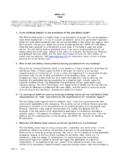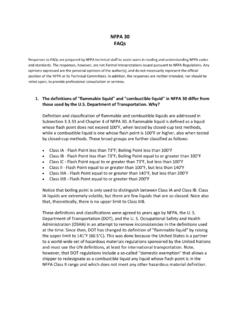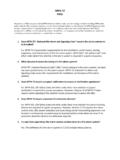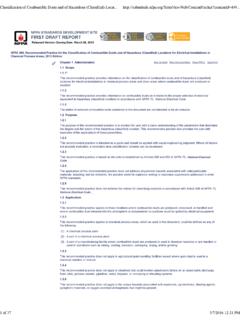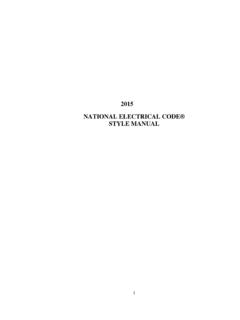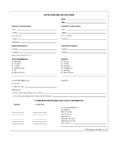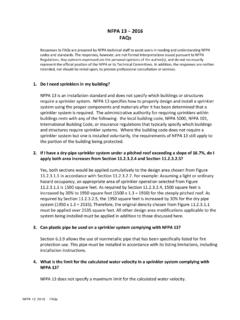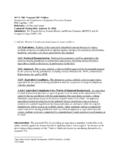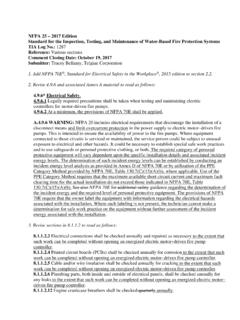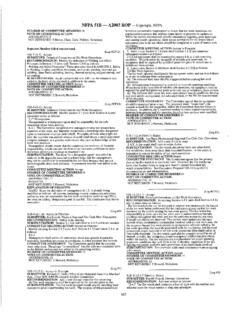Transcription of NFPA 25 FAQs - National Fire Protection Association
1 nfpa 25 faqs nfpa 25 faqs Responses to faqs are prepared by nfpa technical staff to assist users in reading and understanding nfpa codes and standards. The responses, however, are not Formal Interpretations issued pursuant to nfpa Regulations. Any opinions expressed are the personal opinions of the author(s), and do not necessarily represent the official position of the nfpa or its Technical Committees. In addition, the responses are neither intended, nor should be relied upon, to provide professional consultation or services. 1. When inspecting an old system (60 years or older), when/where does nfpa 25 require a system to be upgraded to present standards?
2 nfpa 25 does not require any system modifications to bring an old system up to present standards. There are exceptions however. If the authority having jurisdiction determines that an unsafe condition exists, Section permits corrective action in excess of the minimum requirements of the standard. Another exception to this requirement can be found in which states "sprinklers installed prior to 1920 shall be replaced" 2. If an existing system is found to contain installation deficiencies, where in the standard does nfpa 25 require corrective action?
3 nfpa 25 is not intended to address installation deficiencies. In fact, Section states "Where a system has not been installed in accordance with generally accepted practices, the corrective action is beyond the scope of the standard" 3. Am I required to have a license in order to perform testing or maintenance on a water based system? Many state or local jurisdictions require licensing or certification, nfpa 25 does not. Section states that "These tasks shall be performed by personnel who have developed competence through training and experience".
4 4. What type of tests, if any, are required when a system component is replaced or rebuilt? Section requires testing in accordance with the original acceptance test for that component or subsystem. This information can be found in the installation standard for the type of system involved. 5. Is an obstruction investigation required every five years? There are two activities that are related to obstructions in Chapter 13 that require our attention. The first is an investigation that is actually more of an inspection as described in Section that must be conducted every five years.
5 While the sprinkler system is shut down for the purpose of internal valve inspections (See Table ), the flushing connection at the end of one crossmain and a single sprinkler at the end of one branchline must be nfpa 25 faqs removed and the inside of the piping is then inspected for the presence of organic and inorganic material. In Section a more comprehensive obstruction investigation must be conducted when any of the 14 conditions listed in that section are present. This more comprehensive obstruction investigation is conducted by internally examining the following four points in a system: system valve, riser, crossmain and, branchline and is only required when one of the 14 problems listed in Section is present.
6 This obstruction investigation is not a routine procedure, it is only needed when a problem exists. If any obstructing material is found, a complete flushing program must be conducted to remove any remaining obstructing material. 6. Are bags (paper or plastic), acceptable to protect sprinklers from accumulation of dust or other potential contaminants? Bags are only permitted when sprinklers are protecting spray coating areas. Plastic bags must have a minimum thickness of in. ( mm) or small paper bags may be used. Sprinklers protecting areas other than spray coating hazards are not permitted to have bags placed over the sprinklers.
7 7. What is meant by "indivdual sprinkler sample" as referenced in Section , does this pertain to the style of the sprinkler (such as upright, pendent etc.)? Individual sprinkler sample refers to each type of sprinkler in a system. For example, if a system contains upright and pendent sprinklers, one percent or not less than four of each type must be removed for testing. 8. If a system has only one riser but serves several tenant spaces, such as a strip mall, should a sprinkler sample be taken from the system as a whole or from each individual tenant space?
8 In your case, a sample from each tenant space is not required. The sampling requirement in Section is intended to be random sampling, meaning that sprinklers should not be removed from a single branchline but should be taken from a number of different areas in a building (where practical). Removing sprinklers from as many different areas as possible will better represent the condition of all or most of the sprinklers in that system. 9. How many sprinklers must be removed from a system for testing? Section requires that one percent (or no less than four) be removed and submitted to a testing laboratory for evaluation.
9 If a system contains 500 sprinklers for example (400 upright and 100 pendent) then a total of eight sprinklers must be removed; and (but not less than 4). nfpa 25 faqs 10. Our local high school is fully sprinklered. The sprinklers located in the swimming pool area have turned green. Are these sprinklers required to be replaced? Yes. Any sprinkler found to be corroded must be replaced in accordance with Section Anytime brass is exposed to constant moisture (particularly combined with chlorine), corrosion will result. Sprinklers exposed to these conditions, should be wax coated to protect the sprinkler from corrosion.
10 Wax coated sprinklers are available from any sprinkler manufacturer. Wax is not permitted to be applied after the sprinkler leaves the manufacturer. 11. When replacing sprinklers in a system, is it necessary to perform a hydrostatic test? Section of the standard refers to nfpa 13 "Standard for the Installation of Sprinkler Systems" when maintenance or repair involves more than 20 sprinklers. This section is intended to address common installation issues such as pipe, fittings, hangers and so on. It is sometimes a common practice to hydrotest a system without sprinklers installed, : with " plugs installed in the bottom of a drop to a pendent sprinkler and then install the sprinkler after final adjustment of the drop once the finished ceiling is installed.
